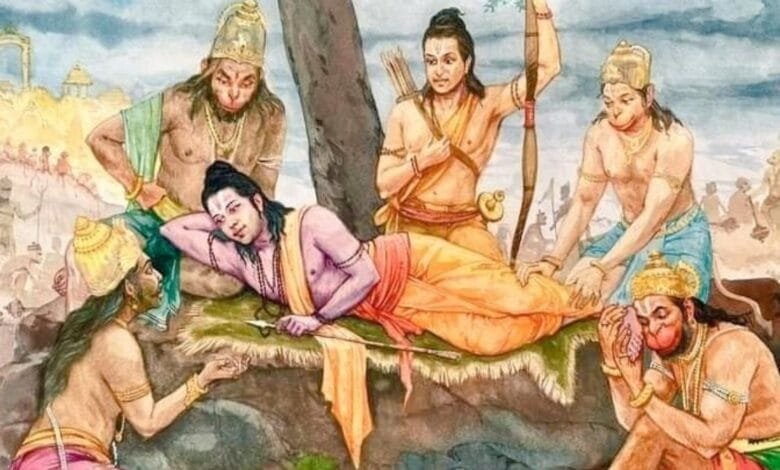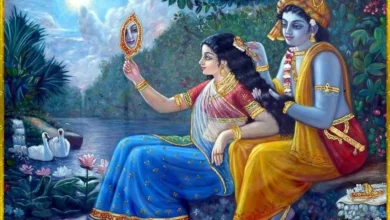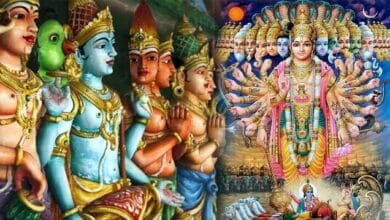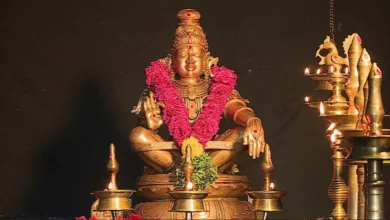The Mighty Hanuman in Mahabharata: When His Glance Made Armies Flee

The Mighty Hanuman in Mahabharata: When His Glance Made Armies Flee
The Mahabharata, one of India’s greatest epics, is filled with tales of valor, divine intervention, and extraordinary warriors. Among these narratives, one of the most awe-inspiring yet lesser-known stories is that of Lord Hanuman’s presence during the great Kurukshetra war. While most devotees associate Hanuman Ji with the Ramayana, his role in the Mahabharata reveals dimensions of his power that are truly unimaginable.
Hanuman’s Divine Presence on Arjuna’s Chariot
During the eighteen-day war of Kurukshetra, Hanuman Ji graced Arjuna’s chariot with his presence, seated atop its flag as a protective deity. This wasn’t merely symbolic—his presence served as an impenetrable shield for the Pandava prince and Lord Krishna, who served as Arjuna’s charioteer.
What made Hanuman Ji’s presence truly formidable was not just his physical proximity but the sheer power of his gaze. Historical texts describe how whenever Hanuman Ji would stand up and glare at the Kaurava army with his penetrating eyes, an extraordinary phenomenon would occur. The entire Kaurava army, comprising thousands of seasoned warriors, would flee the battlefield with the speed of a tempest. No soldier, no matter how brave or accomplished, possessed the courage to withstand the intensity of Hanuman Ji’s divine sight.
This wasn’t fear born of ordinary intimidation—it was the overwhelming recognition of absolute power. The warriors sensed instinctively that they stood before a being whose strength transcended all earthly measures.
The Fateful Day: Karna Versus Arjuna
The incident that truly showcased Hanuman Ji’s immeasurable power occurred during one of the war’s most anticipated confrontations—the battle between Karna and Arjuna. These two supreme archers, bound by destiny and rivalry, finally faced each other on the battlefield, and the clash was nothing short of apocalyptic.
Karna, wielding his divine weapons and driven by years of accumulated resentment, unleashed a devastating barrage of arrows upon Arjuna’s chariot. His archery was so precise and powerful that even Lord Krishna, despite being the Supreme Godhead, was struck by multiple arrows. The intensity of Karna’s assault was such that Krishna’s protective armor shattered and fell away, leaving him exposed.
Arrow after arrow began piercing Krishna’s tender divine form. Blood trickled from wounds on his sacred body as Karna continued his relentless offensive, determined to prove himself the superior warrior.
The Moment of Divine Fury
Throughout this assault, Hanuman Ji sat atop the chariot’s flag, his eyes fixed unwavering on his beloved deity below. He watched as his lord—the same Krishna who had appeared before him in Ram’s form, the same divine being he had served across yugas—stood defenseless and wounded.
As Krishna’s armor lay broken and Karna’s arrows continued to pierce his divine body, something within Hanuman Ji stirred. The sight of his beloved lord being struck repeatedly became unbearable for the devoted servant. The one who had crossed oceans, burned Lanka, and served with absolute humility could no longer remain a passive witness.
In a sudden movement that shook the very foundations of existence, Hanuman Ji rose to his feet. His thunderous roar split the heavens—a sound so terrifying and powerful that it seemed as though the entire universe had been torn asunder. Both his mighty arms raised high, Hanuman Ji prepared to strike down Karna and end the battle in a single devastating blow.
The Cosmic Impact of Hanuman’s Wrath
The effects of Hanuman Ji’s fury were immediate and catastrophic. The Kaurava army, which had already experienced the terror of his gaze, fled en masse from the battlefield without a moment’s hesitation. But this time, even the Pandava army—fighting on the same side as Hanuman—began to scatter in panic. Warriors who had faced death daily for weeks found themselves paralyzed by primordial fear.
Karna himself, the invincible warrior who had never shown fear before any opponent, stood frozen. His legendary bow Vijaya slipped from his trembling hands and clattered to the ground. Both he and his charioteer began shaking uncontrollably, recognizing that they stood before a force against which all their martial prowess meant nothing.
Krishna’s Divine Intervention
Witnessing the situation spiraling beyond control, Lord Krishna immediately stood up in the chariot. He raised his right hand and touched Hanuman Ji, speaking with firm authority: “Stop! This is not the time for your anger.”
Krishna’s divine touch had its effect—Hanuman Ji paused his advance. However, his rage had not fully subsided. His massive tail stood erect, swaying violently in the sky like a cosmic serpent. His fists remained clenched so tightly that they seemed capable of crushing mountains. His teeth were bared in fury, and his eyes—blazing like twin fires—continued to bore into Karna with devastating intensity.
Even in this restrained state, Hanuman Ji’s appearance was so terrifying that Karna and his charioteer continued trembling, unable to regain their composure.
The Lesson of Different Yugas
Seeing that Hanuman Ji’s anger was not abating, Krishna spoke again, this time with even greater firmness: “Hanuman! Look at me. If you continue gazing at Karna for even a few more moments, he will die from your sight alone.”
Then Krishna delivered words that revealed the true extent of Hanuman Ji’s power: “This is not Treta Yuga. Forget your valor—even your radiance cannot be endured by anyone here. I have asked you to remain calm and seated throughout this war.”
These words carry profound significance. Krishna—the Supreme Lord himself—acknowledged that in Dwapara Yuga, the age in which the Mahabharata occurred, no warrior could withstand even Hanuman’s brilliance, let alone his full might. The implication was clear: Hanuman’s power belonged to an earlier, more divine age, and its unleashing in the current era would destroy the very fabric of dharmic warfare.
The Return to Serenity
Only then did Hanuman Ji lower his gaze from Karna and look down at his beloved deity Krishna. The anger that had threatened to annihilate armies dissolved in an instant. The supreme devotee, recognizing his lord’s will, became calm and seated himself once again atop the chariot’s flag.
This transformation—from world-destroying fury to perfect tranquility—demonstrated another aspect of Hanuman Ji’s greatness. His power was matched only by his surrender to the divine will. Despite possessing the strength to end the war single-handedly, he chose obedience over action, restraint over revenge.
The Deeper Meaning
This Mahabharata episode reveals several profound truths about Hanuman Ji and the nature of divine power:
The Timelessness of Devotion: Hanuman’s presence in the Mahabharata, long after the events of the Ramayana, shows that true devotion transcends time. Wherever his beloved Lord appears—whether as Ram or Krishna—Hanuman is there to serve.
Unmatched Power Held in Check: The story illustrates that the greatest strength lies not in display but in restraint. Hanuman possessed the power to end the war instantly, yet he chose to remain a silent protector, unleashing his might only when his lord was endangered.
The Different Yugas: Krishna’s reference to Treta Yuga versus Dwapara Yuga highlights how divine power manifests differently across cosmic ages. What was normal in Ram’s time was overwhelming in Krishna’s era.
The Supremacy of Divine Will: Despite his overwhelming urge to protect Krishna, Hanuman immediately surrendered when asked. This shows that even the most powerful devotee places the Lord’s wishes above personal instincts.
The Terror of Pure Power: The fact that Karna—who had faced gods and demons—became paralyzed before Hanuman’s anger reveals that spiritual power operates on an entirely different dimension than martial prowess.
Historical and Scriptural Context
This incident, though less widely known than other Mahabharata episodes, appears in various Sanskrit texts and regional retellings of the epic. It explains several mysterious elements in the Mahabharata narrative, such as why Arjuna’s chariot remained largely undamaged despite facing the mightiest warriors, and why certain critical moments seemed to turn in the Pandavas’ favor beyond mere skill.
The presence of Hanuman on Arjuna’s flag wasn’t coincidental. It was Krishna’s own arrangement, knowing that the war would require protection beyond what even he, in his limited avatar form as a charioteer, might openly provide. Hanuman’s presence ensured that regardless of the weapons used or curses invoked, the Pandava cause would remain protected by Treta Yuga’s mightiest devotee.
The Message for Devotees
For modern devotees, this story carries powerful lessons. It reminds us that Hanuman Ji is not merely a historical figure but an eternal presence, appearing wherever dharma needs protection and devotion calls. His power remains undiminished across ages, waiting to be invoked by sincere prayer.
The story also teaches us about the relationship between power and devotion. Hanuman could have ended all conflicts with a single roar, yet he chose to serve silently, acting only when absolutely necessary. This is the model of true spiritual strength—mighty yet humble, capable yet restrained, powerful yet surrendered.
The tale of Hanuman Ji’s fury during the Karna-Arjuna battle stands as one of the most dramatic demonstrations of divine power in Hindu mythology. It reveals that behind the façade of human warfare, cosmic forces were at play, with beings of incomprehensible might maintaining the delicate balance that would allow dharma to prevail.
When we chant Hanuman Ji’s name or seek his blessings, we’re not merely calling upon a legendary figure from ancient epics. We’re invoking a living presence whose glance alone could scatter armies, whose roar could shake the cosmos, and whose devotion could move the Supreme Lord himself. Yet this same mighty being sits humbly in our hearts, waiting to destroy our inner demons with the same ferocity he reserved for the enemies of dharma.
This Mahabharata episode reminds us that true power serves love, that genuine strength bows before devotion, and that the mightiest force in creation is not fury unleashed but fury restrained in the service of the divine will.
Jai Hanuman! Jai Sri Ram!
Discover more from Sanatan Roots
Subscribe to get the latest posts sent to your email.



4 Comments